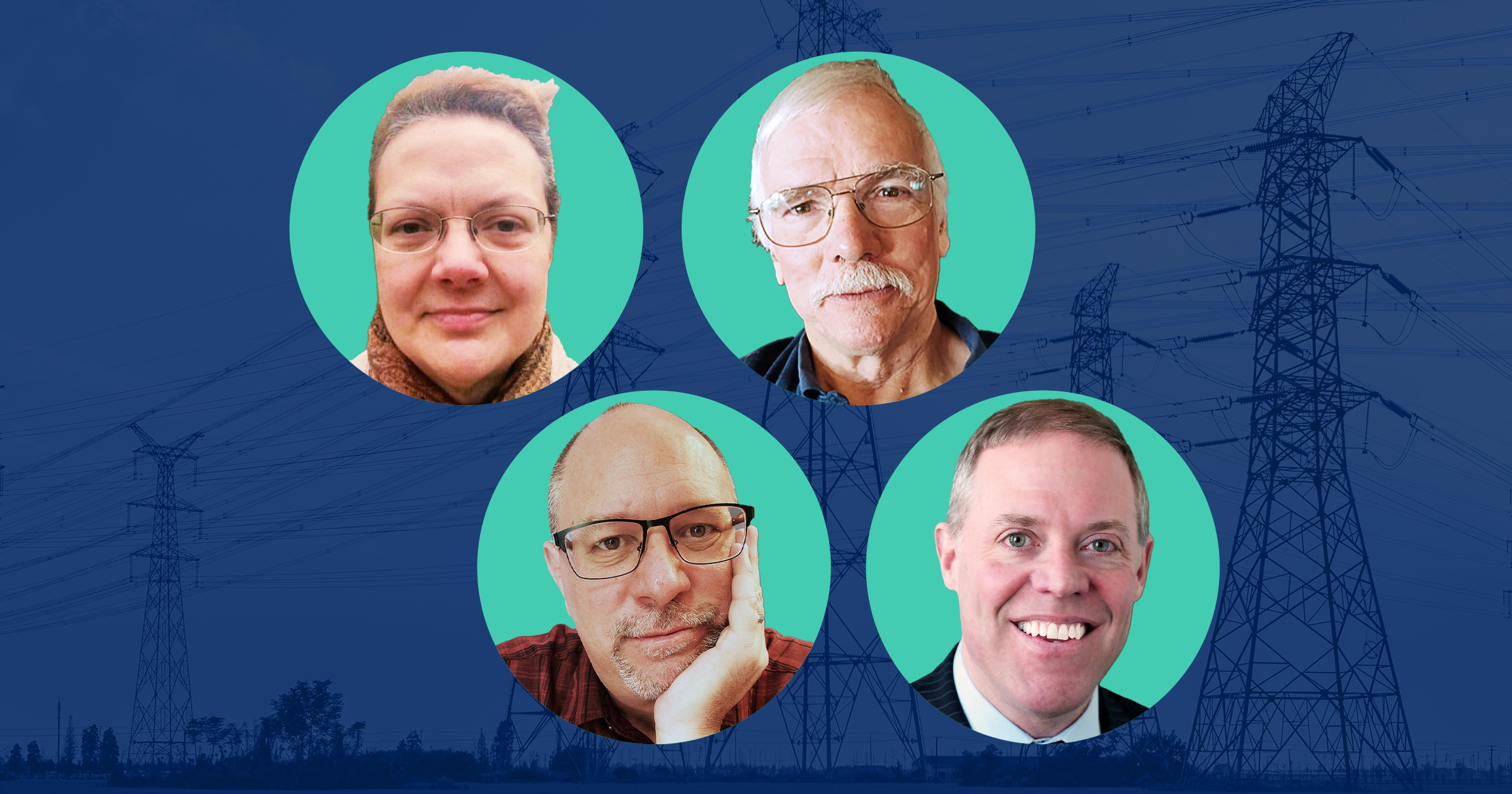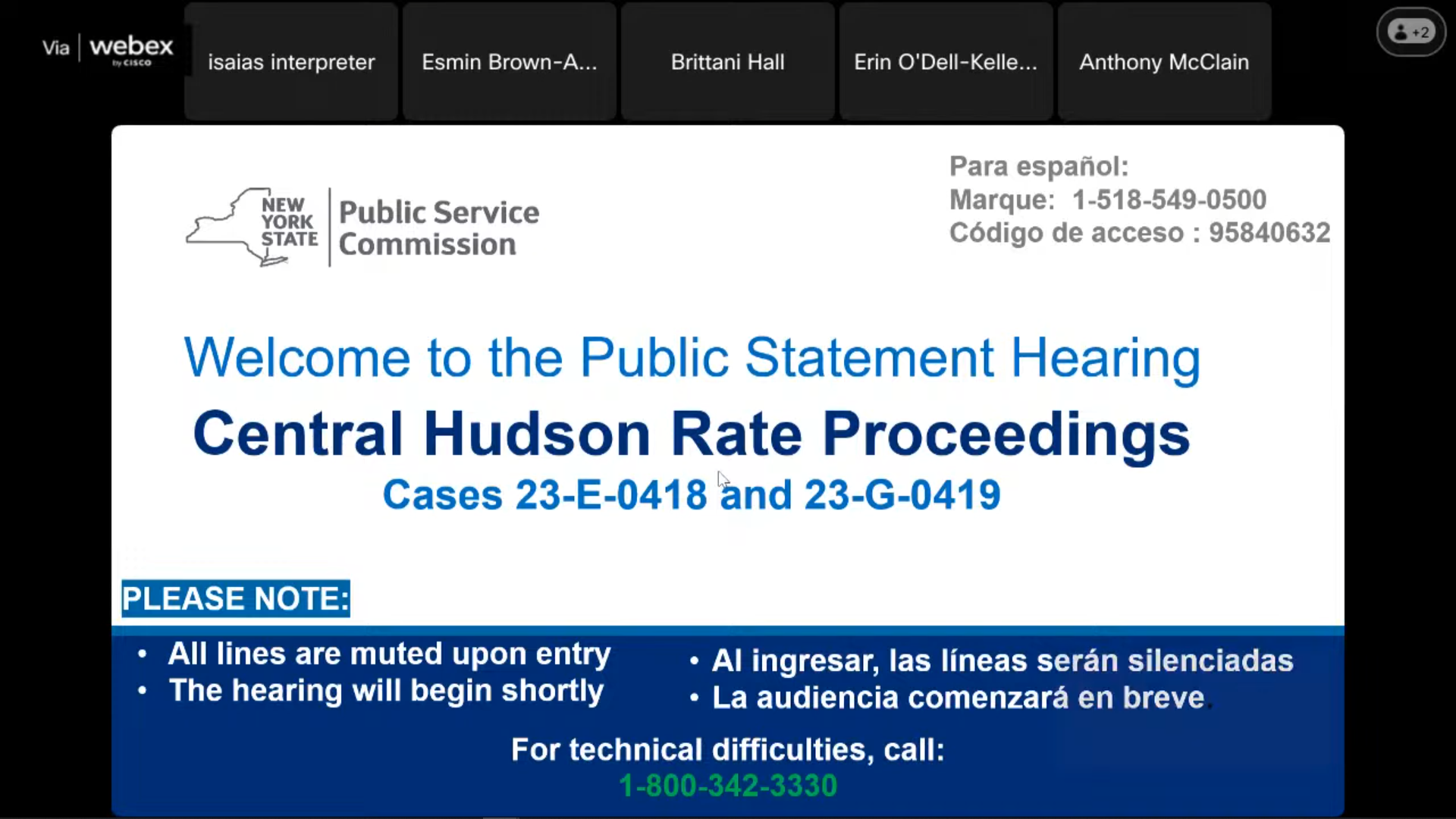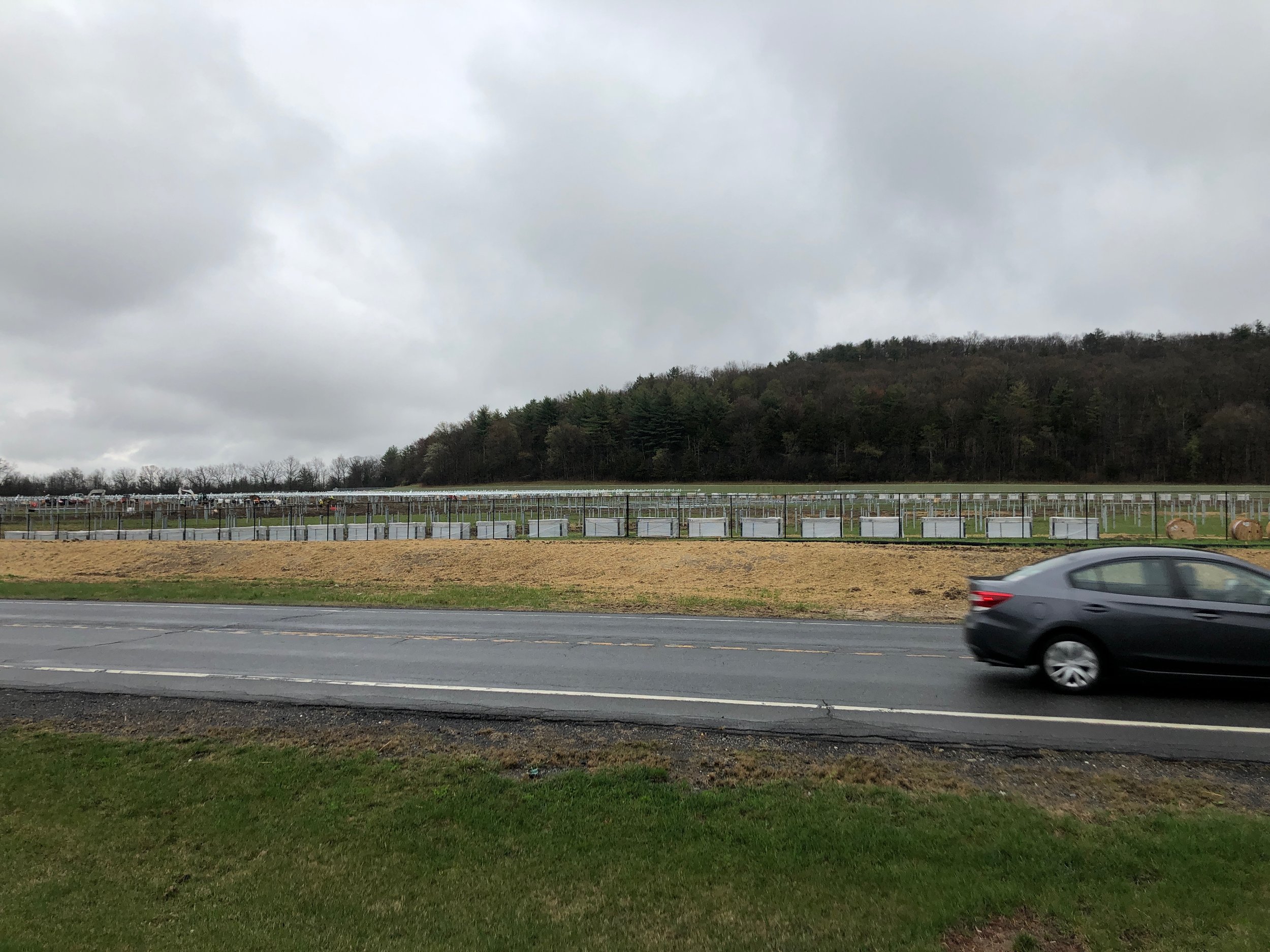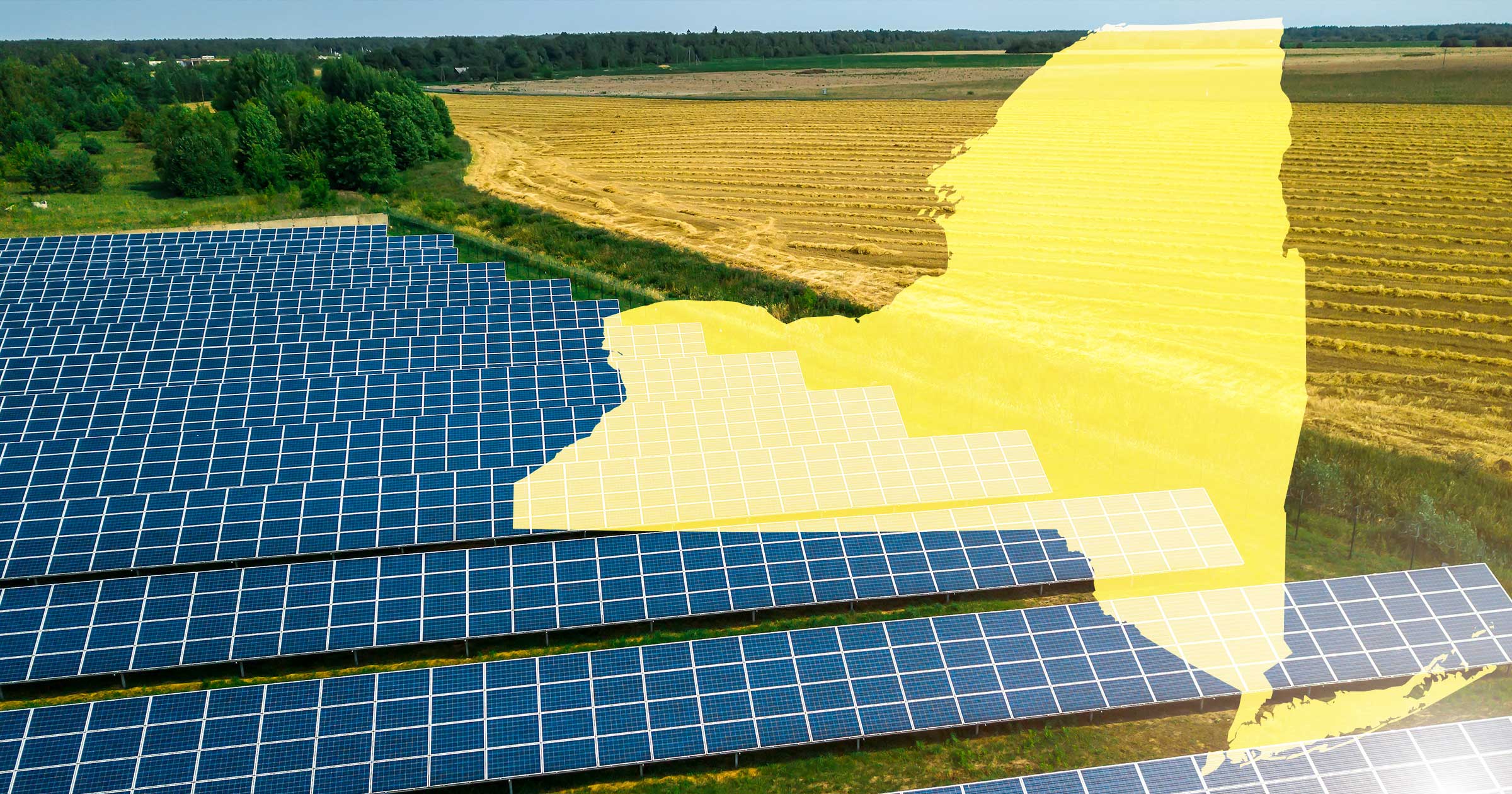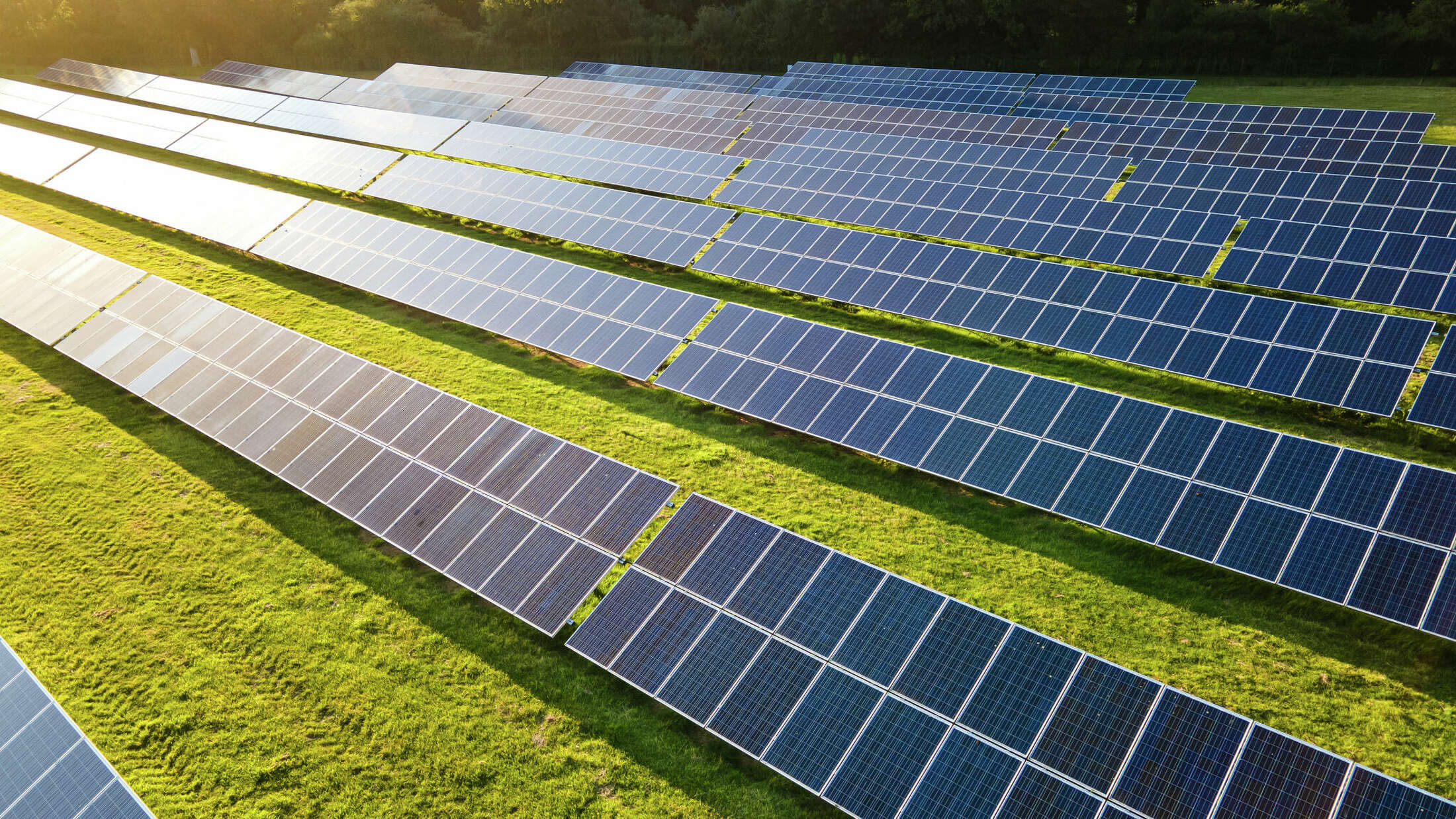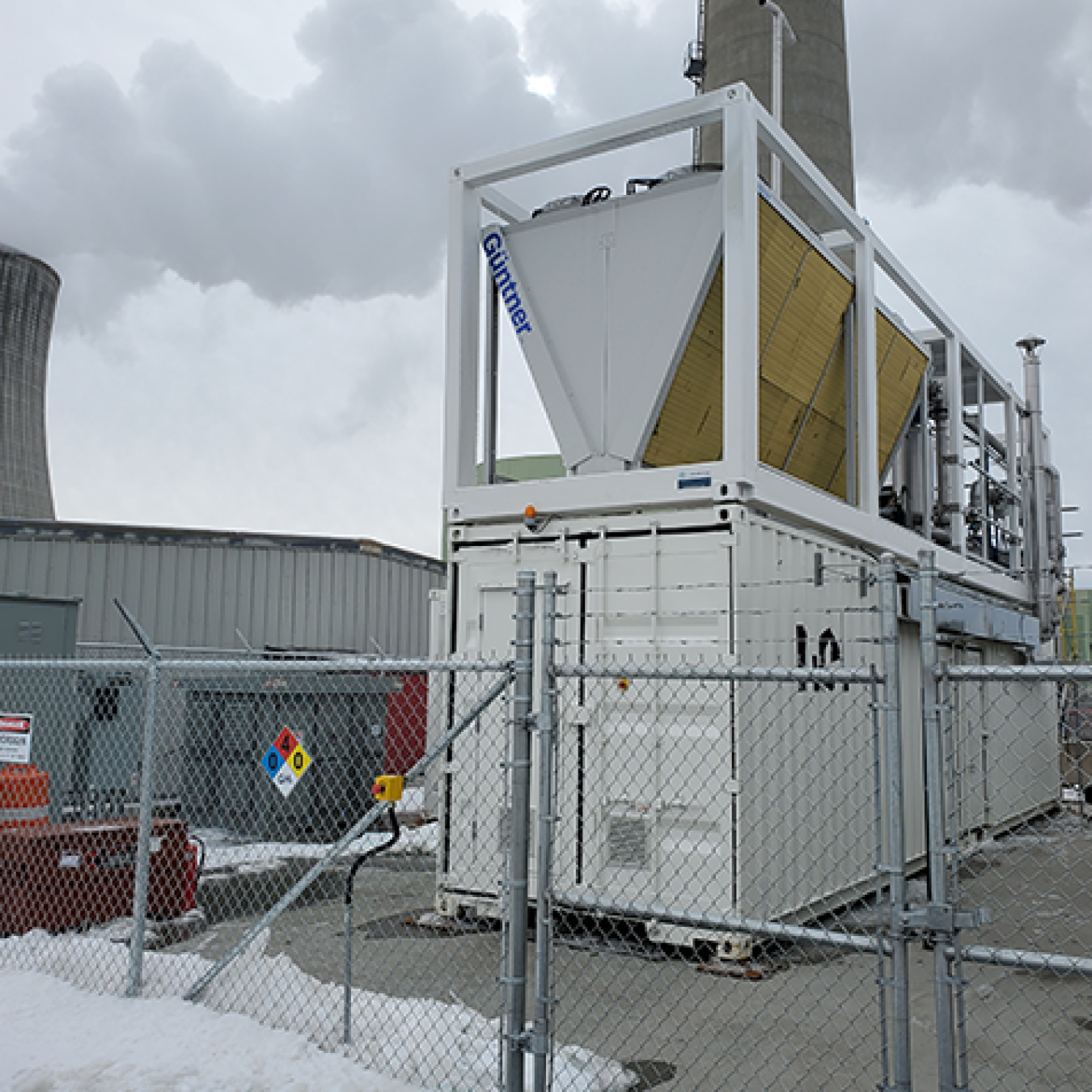As New Yorkers enter 2024, everything seems to be up in the air. An all-consuming, yearlong referendum on the last decade is coming, from the hyperlocal to the national level.
One area that figures to play a heightened role is the nexus of land use, energy policy and climate change. How will billions of dollars of promised government investment in renewable energy affect New Yorkers’ pocketbooks, farms, viewsheds, and energy reliability? Do New Yorkers know what have, or haven’t, signed up for? What can be done in time to make a difference?
The four people below are trying to answer those questions.
1. Kris Martin, Saving Greene: Citizens for Sensible Solar

While focusing on renewable energy and land use issues in Greene County (which straddles the Mid-Hudson Valley, Hudson River, the Catskills, and the Capital Region), Kris has created a number of fundamental resources for anyone looking to learn more about the impacts of climate mandates on Upstate New York. The latest is a 65 page report on solar’s impact on farmland titled Enough Land, which can be found on Kris’ Substack.
Background
I grew up in a farming community in western New York, in Allegany County. I earned a master’s degree in technical communication from RPI and worked for IBM research and development in Kingston and Westchester County until retiring. After moving back to western New York a couple of years ago, I changed my focus from activism to doing research and writing about renewable energy issues.
Getting Into the Solar Resistance Movement
I’ve been interested in solar technology, climate issues, and reducing my carbon footprint since college. In 2017, I invested $40,000 of my retirement savings in a ground-mounted residential solar array. It was my own tiny contribution to fighting climate change, and I was proud of it. Then in 2018, two grid-scale solar projects were announced for the town where I lived. One was across the road from me, and the other was in my backyard. In fact, I supported the project in my backyard. The one across from me, though, was sited on hundreds of acres of active farmland, wetlands, and habitat for threatened and endangered species, all surrounded by homes.
At first, the developers showed us a project map showing 800 acres covered solidly with solar panels. It was crazy: there were panels five feet from the road. I couldn’t support that, so I joined the local “opposition” group, Saving Greene: Citizens for Sensible Solar. Eventually I became their research and communications coordinator. After proudly telling the press they’d downsized the project, the developers showed us new maps with the project now on 400 acres. These were the real maps, not the decoy they’d showed us up front. A friend in the industry explained that we were supposed to have panicked over the first map and been reassured by the second; it was a common enough strategy for manipulating how people viewed these projects. This time it had backfired by stirring up real distrust and opposition in the community.
One of the developers came out to my house and was very pleasant, very cheerful. We stood on my front porch, and he said, “Well, you’ll lose your view.” Then he added that my property value would probably increase. I knew the property-value study he was referring to. It applied to wind projects, not solar.
I always assumed solar developers wanted to help fight climate change. Some may, but many don’t seem to care about it at all. They trot out climate change when they want to shame the people who oppose their projects and cut into their profits. They use shame as a weapon. Calling us NIMBYs is the easiest way of attacking and shaming us, the best way to turn other people against us.
I asked the developer who’s buying this electricity. It was a very roundabout answer: 40% of the electricity was being sold to a company in Connecticut. They were getting state funding from NY to do this. I began to get very suspicious of the solar industry. I’ve gotten to the point that the solar industry isn’t here to save us, they’re here to profit from climate change.
There was no one helping us. We seriously looked. NPR and such have accused the groups like ours of being funded by fossil fuel companies. But the money was coming out of our own pockets.
At first, I didn’t find anyone who was opposing or questioning. The people I ended up talking to were solar developers and off the record. That’s where I learned much of what I knew initially.
We were the first group to oppose grid scale solar. There were groups opposing wind in Upstate NY. If I got any information from anyone on how to oppose this, it was from wind people.
Enough Land
I’d collected information and written about solar topics before, but nothing on the scale of Enough Land, my white paper on agriculture and solar land use. It took over three years to research and write. I wanted to answer the question: Do we have enough land for agriculture and solar buildout?
I kept hearing we only need 1% of the state’s land for solar, as if that’s somehow meaningful. It’s not. Solar projects have very specific land requirements, and the best land for solar is often the best land for farming. The solar industry wants us to think they’re saving struggling family farmers. But they’re also really hurting farmers who need to rent the land being converted for solar. In fact, the majority of upstate farmers expect solar to harm their operations.
“Who’s Buying the Electricity?”
When I looked into who was buying the electricity from the project I was opposing, I learned that 40% was being sold to a Connecticut utility. New York taxpayers were paying for the expensive review and approval process, and New York was counting the project’s capacity toward its clean energy goals. Connecticut was counting it toward theirs. It was all a numbers game. I’m disgusted by what’s being done in the name of fighting climate change. The climate industry isn’t here to save us from ourselves; it’s here to profit from climate change.
Saving Greene was the first group to oppose grid-scale solar in upstate New York. We didn’t have much in the way of resources, and getting accurate information was incredibly hard at first. It still isn’t easy. The people who helped me the most were solar developers who didn’t like how things were playing out and people who had opposed wind projects in the past. They’d faced some of the same issues that we were starting to encounter, and they provided solid advice. Even now, there aren’t many resources available to groups that are starting up. Until recently there hasn’t been a real effort to bring them together as a coalition. I’m glad to see this changing.
NPR accuses groups like Saving Greene of being funded by fossil fuel companies and backed by mysterious Republican interests. You don’t need to invent conspiracy theories to explain solar resistance. As an activist, I found that incredibly offensive and disappointing. I used to support NPR, but I can’t take them seriously anymore. Quite a few of us in Saving Greene were progressive Democrats, and our funding came from the community and our own pockets. Some of us are still paying off expenses. It’s so easy to pretend that the solar resistance movement results from ignorance and malice. I’m constantly having to explain that there are real, solid issues to discuss.
I’m not claiming the resistance movement has all the answers. We don’t. For instance, I’ve heard people opposing large projects claim that panels are leaching toxins into the soil. Then they turn around and say solar should go on residential rooftops instead. Are they listening to themselves?
The “Ridiculous” Climate Leadership and Community Protection Act
When I first looked at the Climate Act, it seemed ridiculous. It’s not achievable. It wasn’t thought out by energy experts; it was written by politicians. The scope and timeline are way too ambitious; I feel like it’s setting us up for failure. To our politicians, decarbonizing our economy quickly is more important than doing it right. In our rush to be first, we won’t be able to take advantage of emerging technologies and approaches, like agrivoltaics [the co-location of agriculture and solar development]. In a few years, when states like North Dakota start building out solar, they’ll have better options for preserving farmland than we have now in New York. We’re chasing numbers, not making meaningful changes.
I listened to dozens of Climate Action Council meetings; they were trying to make the Climate Act sound workable, and it just wasn’t. No one on the Climate Action Council represented rural upstate New York, where most renewables will be sited. The Council did include lobbyists, though. I wrote comments about issues like electrifying transportation in underserved rural communities, but I knew no one at the state level cared about what happens in these places.
The state seems to have decided that hydro, wind, and solar are our only options for reaching zero emissions. At the same time, they know we need gas to provide stable power when we don’t have breezes and sunbeams. I’m not a fan of gas, but we don’t have a good replacement. The state says we need a resource that’s emissions-free, dispatchable, and economical. They just don’t know what it is, so I call it magic juice. We’re going to backstop solar and wind with magic juice. I have a problem with that approach.
Rebranding With the Build Public Renewables Act
I think the Build Public Renewables Act is essentially rebranding. It addresses some legitimate issues on public vs. private, but mostly it’s another effort to look good in front of the world. Our state government really wants to pat itself on the back.
About 92% of the energy generated upstate is emissions-free, and at least 95% of NYC’s energy is produced using fossil fuels. Some of us view renewable energy buildout as kind of neocolonialism. Upstate New York’s latest purpose is to provide land so NYC can have clean energy. Underserved rural communities are being targeted for buildout. It’s cynical, and it’s wrong.
The Collapse of the Solar Industry
I can’t rule out the solar industry imploding over the next several years. The industry seems more interested in buying and selling corporations, getting tax breaks, and chasing incentives than in producing clean energy. I wonder sometimes if it’ll all come crashing down when you take away those incentives. Providing clean energy for NYC will require an awful lot of very expensive transmission infrastructure. Transmission is usually funded by ratepayers, not by the state. If no one can afford to fund it, of course, there’s not much point in building out large-scale renewables.
When I started to oppose solar projects, I felt like I should have an energy alternative to offer. To my surprise, it ended up being nuclear energy, especially advanced nuclear. Mind you, I protested Seabrook and thought Indian Point was a disaster waiting to happen. I didn’t realize how much propaganda and how little real information was out there. I know it’s an unfashionable solution, but there’s quite a bit of support for it upstate, especially in areas where reactors are located.
How Battery Fire Risks are Confusing
Wait until NYC residents get a good look at their battery situation. Right now, it looks like the downstate region may host at least 19,000 MW of energy storage. That’s 2,000 MW for Staten Island alone, and there are plans to construct a 300-MW battery facility in Manhattan. Residents can’t fight it because it’s being proposed under the state-mandated Section 94-C siting process for renewables. I suspect the NIMBY-haters are going to become NIMBYs themselves when they understand the scope of what’s happening.
My primary concern about battery storage is fire and the release of toxic gases, the potential for disruption of daily life. We’ve had three battery fires in New York this year. Fires can require evacuating half a mile or more around the site. How do you evacuate Staten Island in a matter of minutes? These fires can’t be extinguished with water. They don’t require oxygen to burn. Lithium-ion battery technology wasn’t designed for industrial use, and it’s not a great solution for our energy storage requirements. It’s what we have, though, so we’re using it.
Very few residents know much about battery fires, and they’re getting conflicting messages. The industry says everything is perfectly safe, but then there’s another fire and more evacuations. People are confused. These facilities are going in so fast, and they’re getting so big; the whole thing is a little scary. Most communities don’t even have emergency plans for battery fires. There’s a state task force looking at the issue, but it takes time and experience to develop effective responses. Meanwhile, we’re installing as many of these things as we can. We’re getting ahead of ourselves. Again.
New York needs to stop focusing on looking greener than the rest of the country. Our leaders talk about “nation-leading” policies and goals, but climate leadership shouldn’t be a goal in itself. Getting things right should be the goal.
2. Roger Caiazza, Pragmatic Environmentalist of New York
Since 2017, retired environmental consultant Roger Caiazza has published his analysis of New York State’s energy and climate political economy on his blog, Pragmatic Environmentalist of New York. It goes into the details beyond the idealistic headlines, asking questions how much policies will cost, if the lights will stay on, and if there are environmental tradeoffs.
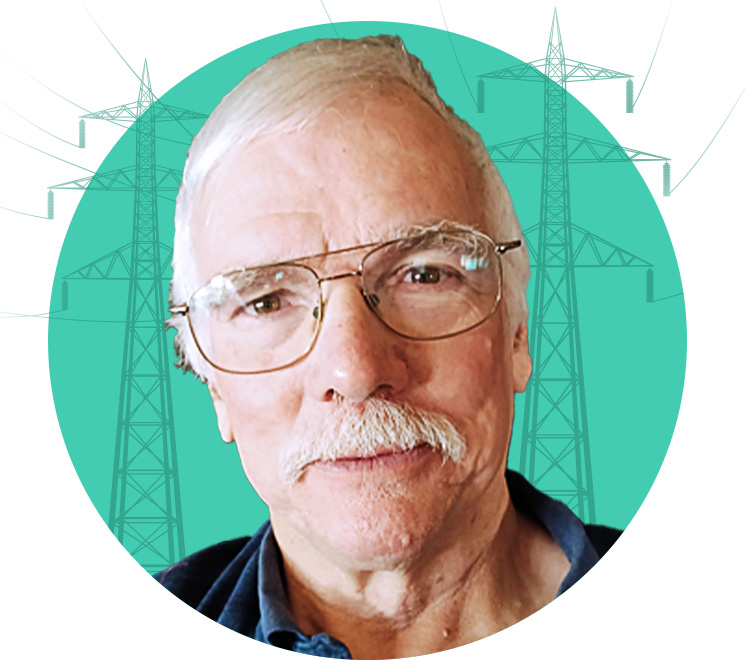
Background
I was born in Cooperstown and raised in Oneonta. Went to SUNY Oneonta, and got a degree in meteorology. I went out of the state from 1974 to 1981, got a master’s degree, and worked in Kansas City and Boston for environmental consulting firms.
In 1981, I came to Syracuse, and got a job with Niagara-Mohawk as their meteorologist and environmental analyst. Since then, I’ve been evaluating different environmental policies related to the energy system.
I worked for Niagara Mohawk until deregulation and they sold off their power plants. I then worked for NRG Energy for ten years. In 2010, I retired from NRG, and then I went to work for the Environmental Energy Alliance of NY, an ad hoc organization. The environmental staff people at all the utilities get together and discuss policy and compliance issues.
In 2017, I stopped being the director, but I still provide support a couple hours a week. There also is a contingency if relevant issues come up. This year, many issues came up.
A Shift Starting in 2000
The members of the Alliance pride ourselves on being the technical people. In the past,. the agencies considered us a resource when they were coming up with regulations. We talked to them very early on in the process and suggested things to consider when developing policy. .” That’s all gone now because politicians drive regulatory policy much more than in the past.
When I retired as the director of EEANY, I set up the blog in 2017. Some of these issues really bother me. “You gotta be kidding me” kind of stuff. I needed to vent. Now I’ve got a blog that has published over 650 articles to get things off my chest.
There has been a shift in the environmental regulatory landscape since I started in New York. Around 2000, there was a shift away from “we’re all in this together”, to “you guys are the evil industry people.” It’s become progressively worse to this point, especially for the utility companies. They rely on the Administration to approve their rate requests. They can’t come out and say “Hey, you guys are nuts,” because there will be retributions. If the state is wrong, and the utilities are right, they can’t say it, because they’ll get hammered. Cuomo led the world in that personal vendetta category. Companies would say, “we have a problem with this,” and he’d come down on them.
That extended to NYISO. In July 2016, NYISO pointed out that in order to do what you want to do with all this renewable energy, you’re going must build all kinds of transmission. They viciously attacked the ISO. Cuomo sicced Energy Czar Richard Kauffman on NYISO, saying “you guys aren’t with the program, you’re just deniers,” and the guy running the ISO left.
It is even worse because under Cuomo, they would put political appointees down at the staff level. Those people were more or less spies. If any staff person stepped out of line, the political appointees at the top knew. So they stifled any dissent No staff in any of the agencies has any reason to speak up with any cautionary tales because it will affect their career path.
And that extends to the companies in the State because they’re going to get hammered. Even if you’re a private company, some day you may need a permit, and they will delay acting on your permit. Against that backdrop, I sort of feel obligated to have someone saying hey, this is all nuts. I don’t go forward without someone having said, it won’t work the way you’re expecting.
CLCPA Concerns Ignored
The Climate Act has become the major topic of the blog. When I stared in 2017, one of the things I wanted to write about was my history with power plant opacity, ie the smoke coming out of the plant. It was actually a non-issue but became an issue because the lawyers could get fines out of it. There were no health effects, it was just entirely aesthetics. NRG paid millions in fines with no value to society. But I never wrote it anything, because I got tied into the Climate Act. The majority of my articles are associated with that now
Putting in regulations that you have to get to zero by 2050 was the kicker. The more research I’ve done on what’s happened since, or how that got developed,has shown it was politically driven by a few individuals since its inception. Honestly there are so many aspects of this that are, oh my god, what you’re doing here is nuts, and it’s just a few people pushing it, and it happens to be who the administration is listening to, while ignoring the system operator, the Reliability Council, the staff people who know what’s going on in the agencies.
When they were going around for the public meetings for the Scoping Plan, I went to a hearing. When I stepped up the mic and gave my presentation, I saw Co-Chairs Seggos and Harris get together and say “that’s the guy.” I get people who can’t be quoted contacting me and saying thank you for doing what you’re doing, and they’ll give me information to look at, that kind of stuff.
Dr. Robert Howarth at Cornell claims to be one of the authors of the Climate Act. They gave him outsized deference during the scoping plan and the Climate Action Council. He was always jumping in saying we don’t need any new technology, it’ll be cheaper, it’ll be wonderful. The Hochul administration should’ve stepped on him and said wait a minute, in the first presentation by NYSERDA and their consultant on what would be needed to change the electric grid to zero emissions, they said we need a new technology, a “dispatchable zero emissions resource”, something you can turn on and off when you need it without any emissions, but it doesn’t exist, unless you’re willing to go nuclear.
So, they could’ve told him to sit down and shut up. “What you’re saying is wrong.” But he was quoted by others members of the council, and it influenced the direction of the Scoping Plan. We’re trying to claw that back now, the PSC in July finally set up a proceeding to figure out what this zero emissions dispatchable resource is going to be. Gee, is this feasible? It’s something new.
The narrative is there’s an existential threat, and the way to address that is to reduce greenhouse gas emissions, because wind and solar are free, it’ll be wonderful. That’s the soundbite. Trying to explain all the problems with different aspects of that, people don’t want to hear it. That narrative is constant. Every day there’s something else, this extreme weather event HAD to be climate change. Oh geez, we’ve installed more solar than coal, whatever number they come up with. It’s constant. People believe it, because it’s so incessant. The NGOs are incessant. If someone steps out of line, they come down hard. TV meteorologists, very few are skeptical now, 10-15 years ago there was an organized campaign to jump on anyone stepping out line.
Searching for the Mythical “Zero Emissions Dispatchable Resource”
The business community rrecently has started to develop a campaign to say timeout. Let’s put this on pause until we figure out how much it’ll cost, if there are real risks to reliability, are there impacts that are being ignored? That’s encouraging. Great Britain in the last week pushed off their timetable for when you have to buy an electric car from 2030 to 2035. They pushed off forcing people to go to heat pumps. When they questioned the Prime Minister, he said people can’t afford it. New York has not reached that point yet but there’s going to be the realization. In July, the PSC came out with their first status report, which didn’t get a lot of publicity. They admitted in the current rate case, 10% of the bill for Niagara Mohawk is for the climate act. It’s just getting started.
The variability and correlation of wind and solar resources is the problem. If you’re going to rely on wind and solar, and we know that wind in particular goes calm, it turns out that it can go calm over a very large area for two weeks. And, in the winter, it’s the time when it’s the coldest weather. How are you going to deal with that? That’s where that zero emissions dispatchable resource comes in. I got myself on the Extreme Weather working group, which is a committee with the NYS Reliability Council. They have analyzed some data looking at potential offshore wind from Virginia to Maine. There was an oh my god moment when they realized they all went calm at the same time.
Trying to deal with that is an enormous challenge. That’s what the Reliability Council and State Integration analysis is worried about. It’s been dismissed so far in no small part because of Howarth. The wind’s blowing somewhere! It’s astounding to me that there are meteorologists saying it too. In Texas, where there was that polar votex, I looked at where the wind was blowing somewhere. For New York, that somewhere was Nebraska. That means there needs to be a dedicated transmission line to Nebraska to dedicated wind farms so we can have energy in NYC when it is needed.: That’s never going to happen. The place holder solution is this magical resource, we’re going to use hydrogen, when we overbuild, we’ll create hydrogen, and store it for use when it is needed 5% of the time That is irrational.
One thing that has been fun with my blog, is that I established contact with other people who have a lot more technical background on specific topics than I do. In this regard, there’s a guy who teaches thermodynamics at some university.. He’s an engineer an d, frankly, thermodynamics was always over my head. Finding somebody who could talk to me and explain things about that has been enlightening. His issue is the second law of thermodynamics. Every time we convert energy some of it is lost. One hundred percent of the solar energy hitting a solar panel takes an immediate hit when converted to electricity. When the energy is stored in a battery, you lose a big percentage. When the battery discharges more energy is lost. When we transmit it, you lose a percentage. In order to maintain reliability all those factors have to be considered. It won’t work. Physics.
What will make the average person notice?
I really think that when people catch onto the costs, and the changes to your personal lifestyle they will rebel. But really, it’s the costs. Roger Pielke’s Iron Law of Climate is, people are willing to pay something, but not a lot. When people catch onto how much they’re going to say wait a minute, timeout.
In NYS, the Hochul Administration has not been up front about what all of this is going to cost. The Hochul administration has never admitted to the costs. The state has forbidden the companies from saying what the costs are explicitly in their bills. The PSC must come out with a report about the costs. Most of the costs in electric bills so far are going to be for putting in the transmission upgrades. When we have to electrify our houses and cars and everything else, you’re going to have to upgrade the distribution system too. Just add a zero at the end of your bill. You’ve got to. I don’t think they will be able to hide that, although they will try.
It’s a good question, are people going to notice in time? Ultimately we’re going to have to vote the clowns out who voted for this. How long is that going to take? I have no guess when it will happen. There’s going to be a timeout, at least. You talk to an environmentalist, and say you’re rushing down this path promising cheaper energy costs. When the costs increase and that claim is debunked then people will say, “Why should I believe you on any this crap?” Eventually people are going to say I’m not going to do what you want.
For timing I would assume in the next governor’s election, it will be an issue. And you know, we’ve got this huge upstate-downstate divide in the politics today. However I think that when all of the apartments and condominiums in big buildings in NYC have to spend millions on Net Zero, I think they will vote for their pocketbooks. They’re going to vote for someone who says no we’re not, we’re not doing this nonsense. And even if we do it, what’s it really going to do for global warming? We’re less than one half of one percent of global emission and global emissions have been increasing by more than one half percent per year for many years Why would we impoverish ourselves for something that is not going to make a difference.
3. James Hanley, Empire Center
James Hanley an independent New York energy policy expert. Follow him on X.

Background
Born in Indiana, went to grad school for political science at University of Oregon. Taught at a small college in Michigan for 20 years and left to pursue something different. I got interested in energy policy, I co-taught a course on nuclear weapons and power with a chemist. We had a lot of fun with it, and it got me interested in thinking more about energy when we covered the prospects for nuclear power in the future. I eventually got a job here at the Empire Center in 2021 focusing on New York energy policy.
First Impressions of New York Energy Policy
My first impressions was that policy was being driven by people who had a very romantic vision without understanding how energy systems actually work. It’s not that the goal of reducing greenhouse gases is terrible. And certainly reducing pollutants from energy production is a very good goal. I have bad asthma myself. The idea of reducing pollutants that cause breathing problems is very near and dear to my heart. Is the cost worth the benefits? For a lot of these people, it’s just an assumption that the environmental cost always outweighs the benefits of anything we can do.
I come from an economics background, so I know that’s not necessarily true. In particular, the environmentalists don’t take the concept of energy reliability seriously. They seem to mystically believe that somehow, some way, there will always be enough energy. That we can easily make it happen. And if we look at the long, long term, sure, we can get there. But it depends on what types of resources we focus on. I am dubious we can get there with just wind and solar. I don’t think energy storage is realistic for dealing with long periods of low wind and solar output. It’s February, the sun goes down at 4:30, there’s a peak for a few hours, batteries might be able to get us through that. But as the Climate Action Council put in the scoping plan, we have to deal with long periods of low sun and wind output. We’re not realistically talking about storage that can cover long periods.
How do you ensure continued reliability while trying to reduce pollution and greenhouse gases? So far, we really only have one answer to that question, and that’s nuclear. I am energy agnostic, but I just don’t see that many actual competitors if those are the goals. Unfortunately nuclear isn’t tremendously cheap. We need clean, cheap and reliable and it’s hard to get all three from one source. The long range costs of nuclear, if you’re looking at the full system costs, are less than wind and solar because you don’t need the cost of storage. In California, as they shift toward renewable energy, they’re paying for the cost of two side by side energy systems, their VRE system and their reliable backup system which is mostly coal and gas. California has cleverly shoved their power production out of state, so they haven’t actually reduced their emissions that much.
Reliability, Costs and Transparency
At the Empire Center, the mission is twofold: we are pro free markets, and we’re government watchdogs looking out for transparency in government. I’m the energy guy. My point of attack is trying to point out the risks of policy, making people aware of the dangers of a lack of reliable energy. Do the benefits outweigh the costs. As we structure these policies, I’m not sure that they are.
The Climate Action Council consultants say that they are, but I’m deeply skeptical. I’ve been trying to get more transparency on these cost estimates. We do a lot of FOIA requests. I keep bugging NYSERDA to tell me this, tell me that, and I hear that it’s privileged information, it’s trade secrets of the consultants. It’s protected because they can’t share information about their proprietary models.
Whether it gets much attention or not, I’m not sure, but NYISO has tried to sound the alarm on the peaker plant rule in NYC and just designated multiple power plants down there as necessary producers, or the city will run a serious power deficit this summer. That may get through to people’s attention. NYISO has to try to prevent catastrophe. There’s a part of me that says the only way we’re going to get through to people is through a blackout, but when we have blackouts, people die. Either people will have a stroke from a lack of air conditioning or at the hospital or whatever. I really don’t want it to happen.
There’s pushback against NYISO about that. Some of the climate activists, or health advocates are upset that the peaker plants are in poorer neighborhoods. The good thing is that we don’t have to use them too often. But when they do turn on they can cause health problems. There’s pushback about using them. The conflict between those voices and NYISO saying that not having them will kill people too, maybe it’ll start to get attention.
Cap and Invest Costs Looming
In terms of the CLCPA in general, the other thing that may get people paying attention is when we enact the Cap and Invest program, energy costs, gas costs, home heating costs will skyrocket, and that will wake people up. A lot of people are going to be unhappy about that.
Right now, the legislature is dominated by pro climate action voices and pro social justice voices. They’re on a roll. There’s no obvious roadblock to them in the immediate future. The DEC and NYSERDA are working on Cap and Invest regulations right now. Within the next year they’ll roll out their proposed policy for public comment, and that’ll take a year. If we’re getting close to a gubernatorial election year, is Hochul able to push back against it coming into effect right away? She’s been tremendously ineffective at getting anything she wants. When they first started looking at the cost of Cap and Invest, Basil Seggos very publicly said the cost of this could be extraordinary. That was kind of their “Come to Jesus” moment.
He said explicitly it could drive gas prices up by 62 cents a gallon, and increase natural gas costs by 80%. Just astronomical. Hochul then said we need to change the way we do accounting from the 20 year accounting to a 100 year accounting. I wrote an explainer on it that’s up on our website. Pretty technical question. New York is one of two jurisdictions that use a 20 year accounting method. Howarth told me that the 100 year accounting method came out of a UN meeting in the 70s, and that it’s outdated. There’s a scientific argument, either you’re more concerned about methane emissions, which trap more heat but drop out of the atmosphere faster, or carbon, which traps less heat but stays in the atmosphere longer.
Choosing a timeframe for accounting for them, it’s a compromise, and we’re trying to account for multiple greenhouse gases. Each lasts a different amount of time, traps a different amount of heat, and we’re trying to put it all in the same framework. It comes down to which chemicals are you most worried about. If you use a 20 year framework, it’ll push you toward faster reductions. That’s why the advocates really want it.
The problem is reducing emissions faster is going to cost more. That’s the magic there. Hochul tried to change to the 100 year plan that everyone else is using, and the climate advocates slapped her down and she backed off quickly. She also lost her Supreme Court appointment battle, the only governor to lose that battle. She’s not politically strategic or effective. When the costs for cap and invest come through, if she’s in an election cycle, people are going to be upset and she’ll be responsive to that. Cuomo was strategically effective if nothing else, and she’s just not.
Part of it is that they want to provide rebates to low and moderate income people. Potentially that offsets their feelings of financial hurt. It might not. It all depends on how it works out in practice. If you pay a whole lot for something, and get a rebate later, people don’t really feel made whole. They feel the hurt from the financial blow more than they feel the compensation months months later.
“They’re lying to us”
They’re frankly lying to us. They’re saying the benefits to New Yorkers will outweigh the costs. Over half the benefits from the CLCPA come from the social costs of carbon. That’s a global benefit. It’s hard to say what share of the benefit we actually get here in New York. I asked NYSERDA in a FOIL, what are the New York-specific benefits? Their accounting are global benefits. Most people haven’t thought about that yet. We have 0.25% of the global population and emit about 0.4% of the global greenhouse emissions.
It’ll be interesting to see what laws or statutes are proposed in the Legislature next year. The one big thing we can be sure about is the development of the Cap and Invest program. That’s a major component to the CLCPA and going after greenhouse emissions.
4. William Barclay, Leader of the New York State Assembly Republican Conference
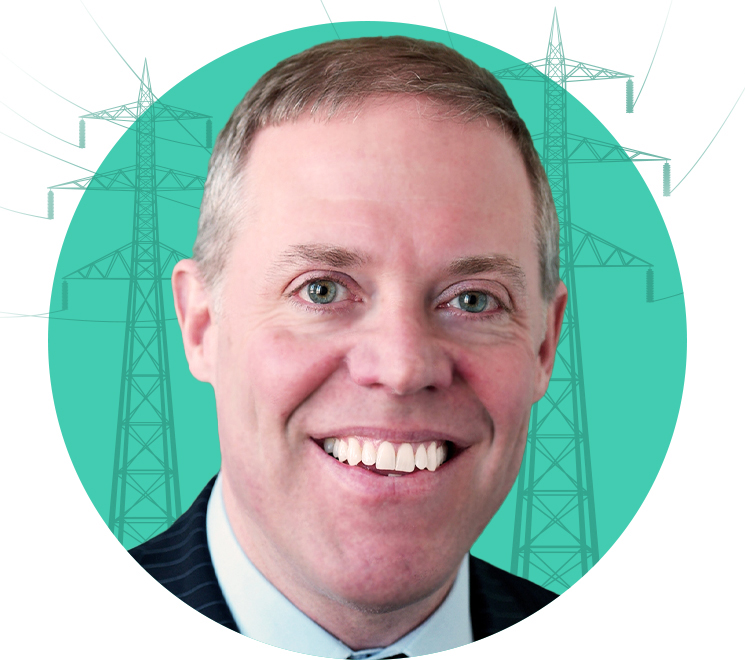
William Barclay is Leader of the New York State Assembly Republican Conference, and has served in the the New York State Assembly since 2003. He has been a leading voice against the mandates of the CLCPA, saying “This plan simply isn’t based in reality. Energy policy without reliable energy production isn’t worth the paper it’s printed on.“
What’s to Come in 2024
Two things are coming to a head, the Democrats seem intent on continuing to implement the CLCPA, which requires us to go on renewables by 2030. That is colliding with the realization that the expense to do what they’re doing with the CLCPA is incredibly expensive. The PSC just rejected 10 billion dollars in additional costs for additional renewable energy projects across the state. The costs are immense, and consumers aren’t always looking at that, but they’re starting to see it. Earlier this year, we heard about the costs of changing over from gas stoves to electric stoves. Something like $35,000 to change your house over. The other one is that electric school buses will cost about $350k, when they normally cost $120k. That will cost the state overall $8B. The costs of implementing this are starting to dawn on the PSC and policymakers.
Cost-benefits ignored to this point
We already have high energy costs for a lot of reasons that are prohibitive. Renewables are not reliable energy, We can’t store enough electricity in batteries. When the sun doesn’t shine, you can’t generate solar, and when the wind doesn’t blow, you can’t generate wind energy. If you’re cutting out your reliable sources like natural gas and nuclear, we’re going to get caught in a pinch.
Experts in the field are warning about it. It hurts economic development; why would you move a company into an area that doesn’t have reliable energy? It hurts citizens who are already here who can’t afford to heat or power their homes. It’s going to hurt economic development and the populace of New York State.
This year with the state budget, the revenue looks okay. But the coming years look problematic. We’ve increased the budget by $60B over the last five years. A lot of that money is going towards subsidizing renewable energy projects. Maybe we’ll get through 2024, but at some point, we’re going to have real constraints on the New York budget and we’ll have to swell that budget down. I hope that we’ll look at the cost benefit of some of these projects throughout the state. NYS only emits 0.4% of global emissions… even if we implement everything and spend $500B, we’re not going to make a dent in global warming, which is the reason given to move over to renewable energy. Maybe this year, it won’t come to a complete head, but we’re going to have some real challenges in our state budget.
By the way, I’m not opposed to renewable energy, but we need balanced energy generation. We can’t transfer over by mandate and expect everything to work, and we can’t shut down generation from nuclear and gas.
The Role of Nuclear
I am heartened by the fact that there have been a number of environmentalists who have pushed against coal-fired plants. They have seen nuclear as maybe a source that can answer the questions. Nuclear is highly efficient, it doesn’t emit, and it’s reliable, those are three very important keys. Ultimately people can wake up to the power of it and how important it is. Even with small modular plants we have to convince people it’s safe generating electricity. I have three nuclear plants in my district, and whether it’s residual holdovers from the 70s, or because the Simpsons didn’t help, but people have a lot of wrong impressions about what the radioactivity of the plants is. It’s important to see nuclear’s key role in solving our future energy challenges, showing that’s its really safe clean way of generating electricity.
Impact on 2024 Governor’s Race?
I hope the cost of what’s being proposed is starting to be realized by NY voters. Whether it’s at the stage yet that it’s going to have an impact on elections, I’m not sure, but I’m certainly going to make it an issue in my races. It’ll become a pocketbook issue. Whether it’s this election or future elections, who knows. I do think it’ll become an issue. The cost of what the Democrats are proposing is so high, it’s going to come from the consumers at some point.

